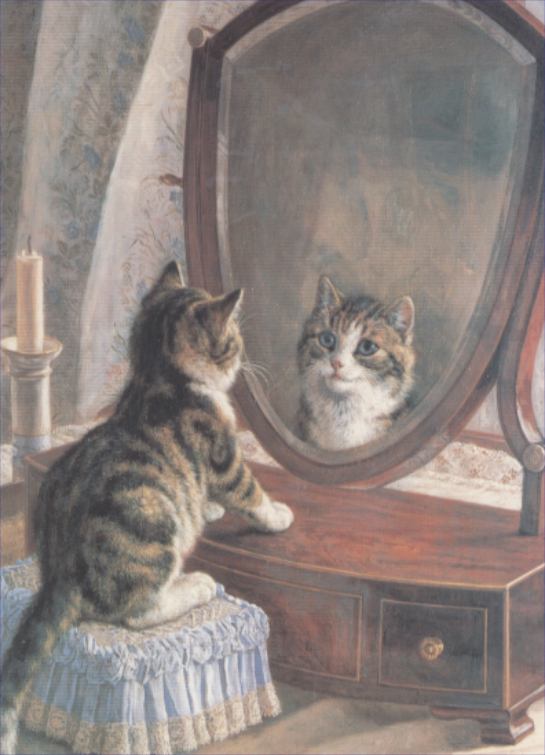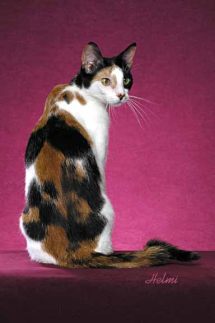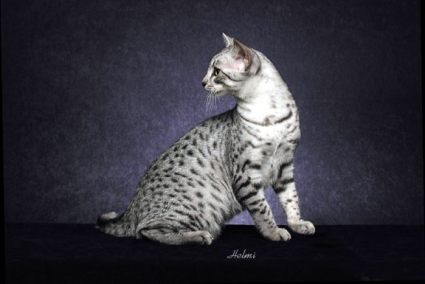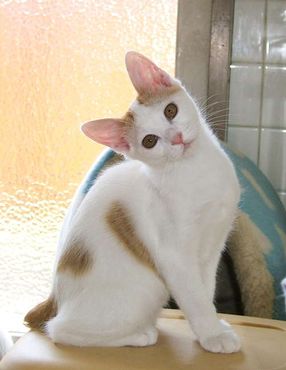 "Looking at the pictures of fluffy Victorian cats with their big eyes and soft faces, lounging lazily on the hearth with colorful bows tied round their necks, one would be hard put to imagine them as anything but adored creatures. Yet, not many generations before, cats had been relegated to the barn to catch mice and to keep the foodstuffs secure from vermin. Rarely did they see the inside of a house - except perhaps the kitchen, cellar or attic. Assigning cats to the task of pest control began in ancient Egypt, where their primary purpose was to keep granaries free from mice that would devour their contents if left unguarded. But even then, though revered for their role in preventing starvation and even elevated to godly form, cats were also beloved pets. The Victorian interest in archaeology uncovered this find. In the 1890s an article in GODEY'S LADY'S BOOK told its readers that the cat was an acceptable and desirable household pet, no longer the stereotypical friend to lonely old ladies: IT IS SETTLED NOW THAT CATS AND SPINSTERHOOD HAVE NO DIRECT CONNECTION, said the article. A learned Egyptologist has just proclaimed the fact that ten well-beloved sacred cats were buried with an Egyptian princess, who had enjoyed the companionship of five husbands in succession. Consequently, it follows that a woman need not be an old maid to appreciate the beauties and love the virtues of her feline companions. Cats in Roman times held a similar position of esteem, accompanying armies of the empire to the stores of food. In the Middle Ages they were not so fortunate, losing their lofty status as they came to be associated with the devil's work. Women who were said to practice witchcraft reputedly kept cats as FAMILIARS - mysterious mediums that facilitated their evil magic. It took centuries for cats to regain their popularity. Generally they were kept simply as utility items, thrown into the barn and otherwise ignored. Not until the 1800s, and the switch from an agricultural to an industrial economy, did the cat once again come into its own. Alive with exciting energy and explosive change, the Victorian era saw a new interest in science, in expansion and exploration, and a different way of looking at the world. In this atmosphere, even the humble working cat took on a new life. Now it became a loved, domesticated pet, invited into the home as a valued member of the family. New wealth allowed the luxury of caring for cats. And just as human food was now being processed and mass distributed (thanks to industrialization), so was food for pets. No longer did cats have to hunt or settle for scraps; special foods were made for them. All this attention, however, did not relieve them of their traditional mousing duties. With cats indoors, Victorians enjoyed a double benefit - beautiful, loving companions and leonine hunters who helped keep their beloved homes rodent-free. The mania for cleanliness during this period was fueled by the findings of Louis Pasteur, whose discovery that bacteria grew and that germs spread in dirty surroundings popularized the new science of hygiene. And what better symbol of hygiene than the cat, who devoted so many hours of the day to washing and preening itself? In England Harrison Weir, an artist and cat fancier, saw potential in feline breeding. I conceived the idea that it would be well to hold Cat Shows, he later said, so that different breeds, colors and markings might be more carefully attended to, and the domestic cat sitting in front of the fire would then possess a beauty and an attractiveness to its owner unobserved and unknown because uncultivated heretofore. His Crystal Palace show of 1871, the first of its kind, listed the permitted breeds as 'BLACK, WHITE and TABBY LONGHAIRS, along with ANY OTHER COLOR. The illustrious winner of the show was a proud Persian kitten. Victorian life was filled not only with actual cats but also with images of cats as decoration. Cat items became the rage. the new department stores were filled with them, and the paraphernalia of advertising reflected the demand. The most effective promotion tools portrayed cats even when the products they advertised had nothing at all to do with them. No item that could hold a picture was missed in the mania for images made by the new technique of Chromolithography, or PRINTING IN COLORS What did the Victorian cat say about the nineteenth century? In many ways, the cat was a crazy
"Looking at the pictures of fluffy Victorian cats with their big eyes and soft faces, lounging lazily on the hearth with colorful bows tied round their necks, one would be hard put to imagine them as anything but adored creatures. Yet, not many generations before, cats had been relegated to the barn to catch mice and to keep the foodstuffs secure from vermin. Rarely did they see the inside of a house - except perhaps the kitchen, cellar or attic. Assigning cats to the task of pest control began in ancient Egypt, where their primary purpose was to keep granaries free from mice that would devour their contents if left unguarded. But even then, though revered for their role in preventing starvation and even elevated to godly form, cats were also beloved pets. The Victorian interest in archaeology uncovered this find. In the 1890s an article in GODEY'S LADY'S BOOK told its readers that the cat was an acceptable and desirable household pet, no longer the stereotypical friend to lonely old ladies: IT IS SETTLED NOW THAT CATS AND SPINSTERHOOD HAVE NO DIRECT CONNECTION, said the article. A learned Egyptologist has just proclaimed the fact that ten well-beloved sacred cats were buried with an Egyptian princess, who had enjoyed the companionship of five husbands in succession. Consequently, it follows that a woman need not be an old maid to appreciate the beauties and love the virtues of her feline companions. Cats in Roman times held a similar position of esteem, accompanying armies of the empire to the stores of food. In the Middle Ages they were not so fortunate, losing their lofty status as they came to be associated with the devil's work. Women who were said to practice witchcraft reputedly kept cats as FAMILIARS - mysterious mediums that facilitated their evil magic. It took centuries for cats to regain their popularity. Generally they were kept simply as utility items, thrown into the barn and otherwise ignored. Not until the 1800s, and the switch from an agricultural to an industrial economy, did the cat once again come into its own. Alive with exciting energy and explosive change, the Victorian era saw a new interest in science, in expansion and exploration, and a different way of looking at the world. In this atmosphere, even the humble working cat took on a new life. Now it became a loved, domesticated pet, invited into the home as a valued member of the family. New wealth allowed the luxury of caring for cats. And just as human food was now being processed and mass distributed (thanks to industrialization), so was food for pets. No longer did cats have to hunt or settle for scraps; special foods were made for them. All this attention, however, did not relieve them of their traditional mousing duties. With cats indoors, Victorians enjoyed a double benefit - beautiful, loving companions and leonine hunters who helped keep their beloved homes rodent-free. The mania for cleanliness during this period was fueled by the findings of Louis Pasteur, whose discovery that bacteria grew and that germs spread in dirty surroundings popularized the new science of hygiene. And what better symbol of hygiene than the cat, who devoted so many hours of the day to washing and preening itself? In England Harrison Weir, an artist and cat fancier, saw potential in feline breeding. I conceived the idea that it would be well to hold Cat Shows, he later said, so that different breeds, colors and markings might be more carefully attended to, and the domestic cat sitting in front of the fire would then possess a beauty and an attractiveness to its owner unobserved and unknown because uncultivated heretofore. His Crystal Palace show of 1871, the first of its kind, listed the permitted breeds as 'BLACK, WHITE and TABBY LONGHAIRS, along with ANY OTHER COLOR. The illustrious winner of the show was a proud Persian kitten. Victorian life was filled not only with actual cats but also with images of cats as decoration. Cat items became the rage. the new department stores were filled with them, and the paraphernalia of advertising reflected the demand. The most effective promotion tools portrayed cats even when the products they advertised had nothing at all to do with them. No item that could hold a picture was missed in the mania for images made by the new technique of Chromolithography, or PRINTING IN COLORS What did the Victorian cat say about the nineteenth century? In many ways, the cat was a crazy

 All child-rearing books warn about cats becoming jealous. After studying the reactions of our cat, our conclusion is that it is not about jealousy: babies crying sound like fighting cats. So a cat could react aggressively thinking there is an intruder. In our case, Choclet is a scaredy cat and so just runs away the moment he cries. He's now beginning to get used to Julian. (Don't worry, we never leave them alone together in a room.)
All child-rearing books warn about cats becoming jealous. After studying the reactions of our cat, our conclusion is that it is not about jealousy: babies crying sound like fighting cats. So a cat could react aggressively thinking there is an intruder. In our case, Choclet is a scaredy cat and so just runs away the moment he cries. He's now beginning to get used to Julian. (Don't worry, we never leave them alone together in a room.) 




















